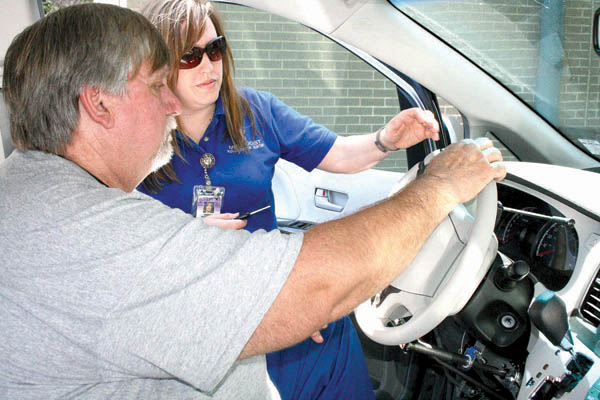The two silver vehicles parked outside Methodist Rehabilitation Center’s Outpatient Therapy Center are, at first glance, nothing special.
The van could be mistaken for any average soccer mom’s grocery getter, while the sedan appears to be your garden variety Chevy Impala, one of the most popular cars on the road today.
But make no mistake, both are in fact packed with the latest advancements in specialized assistive technology that allow disabled persons to regain their independence.
The vehicles are utilized by the center’s Driving Rehabilitation Program, which provides driving evaluations and training for people with disabling conditions such as brain injury, stroke, quadriplegia, paraplegia, spina bifada, epilepsy, brain tumors and conditions of aging.
“Driving is one of the highest level activities of daily living—there’s a lot of physical and cognitive components to driving,” said Ashlee Ricotta, an occupational therapist at Methodist Rehab who administers evaluations for the program. “But, sometimes driving is more feasible than walking, and it opens up a new level of mobility for patients.”
The van has been a significant addition because it accommodates patients the program was previously unable to, such as those who have difficulty transferring from a wheelchair.
“That was something we were not able to do with just a car,” Ricotta said. “Now, we can evaluate people from their chairs, and it allows us to serve a population that we could not before, mainly spinal cord injury patients.”
The van is a 2011 Toyota Sienna Rampvan XT by Braun Ability, which includes a number of standard features to assist disabled drivers and passengers. It has a keychain remote control that also operates the automatic passenger sliding door and automatic foldout ramp.
At the touch of a button, the rear suspension can be lowered to reduce ramp angle and make it easier to enter and exit the van. It also comes with removable passenger and driver’s seats, so that wheelchair users can drive or ride without exiting their wheelchairs.
Handicapable Vans of Jackson further customized the vehicle by installing hand control systems for braking and acceleration, and equipping the vehicle with various assistive steering devices that are matched to each individual driver’s needs. They also added a six-way transfer seat for the driver, which slides back and swivels to allow for easier transfers to and from wheelchairs.
Ricotta is pleased that she will now be able to help even more patients reconnect with something that enhances their daily lives.
“If you see somebody that’s just been told they can drive, well, they’ve gained a feeling of independence that is just immeasurable,” Ricotta said. “If they’ve been cleared to drive—it puts a whole new future out there for them.”
Tommy Burrell agrees. An accounting student at Mississippi College, he recently got his license thanks to the program.
“It feels great,” he said about getting back in the driver’s seat after his injury four years ago. “Now I can use it for getting back and forth to therapy and school, and possibly getting a job.”
But while Ricotta says that most of her patients don’t mind using a minivan for training, Burrell has his eye on something a little more his style.
“Right now I’m looking at getting a Dodge Magnum,” he said. “I’m 26 years old and a van isn’t something I really want to ride around in.”
Charles Tennyson, who is currently working to get his license with the program, intends to get his own van because of the freedom it affords him.
“I hope to become more independent where I can go more places and do more things,” said Tennyson.
A lower leg amputee following a 2010 accident, Tennyson works at The Speed Shop, an auto racing shop in Jackson, and he owns a number of race-modified cars and muscle cars.
A minivan isn’t exactly the kind of hot rod that usually catches his eye.
But the van’s features have won him over, like the ability to enter via the ramp and then get behind the wheel using the six-way transfer seat. This will allow Tennyson to travel alone, as he now needs someone to help stow his wheelchair for him.
“I don’t want to have to depend on someone,” Tennyson said.
The Impala is the newest of the two vehicles and was also outfitted by Handicapable Vans with many of the same modifications such as hand controls for the right or left side, and a left foot accelerator.
The car is typically used in the program by those with less severe disabilities, like paraplegia, stroke and amputations.
Corderris Brown of Terry used the sedan to take his driving test at the Rankin County testing station in mid-September.
For the 26-year-old Brown, who became paraplegic at the age of 17 by an accidental gunshot wound, it wasn’t about getting back to driving—it was about getting his license for the very first time.
“It was easy coming,” he said of learning to drive. “The way Ashlee described how we were going to use it before we got in the actual car, it made it simple.”
For more information about Methodist Rehab’s driving rehabilitation program, call 601-936-8889.



